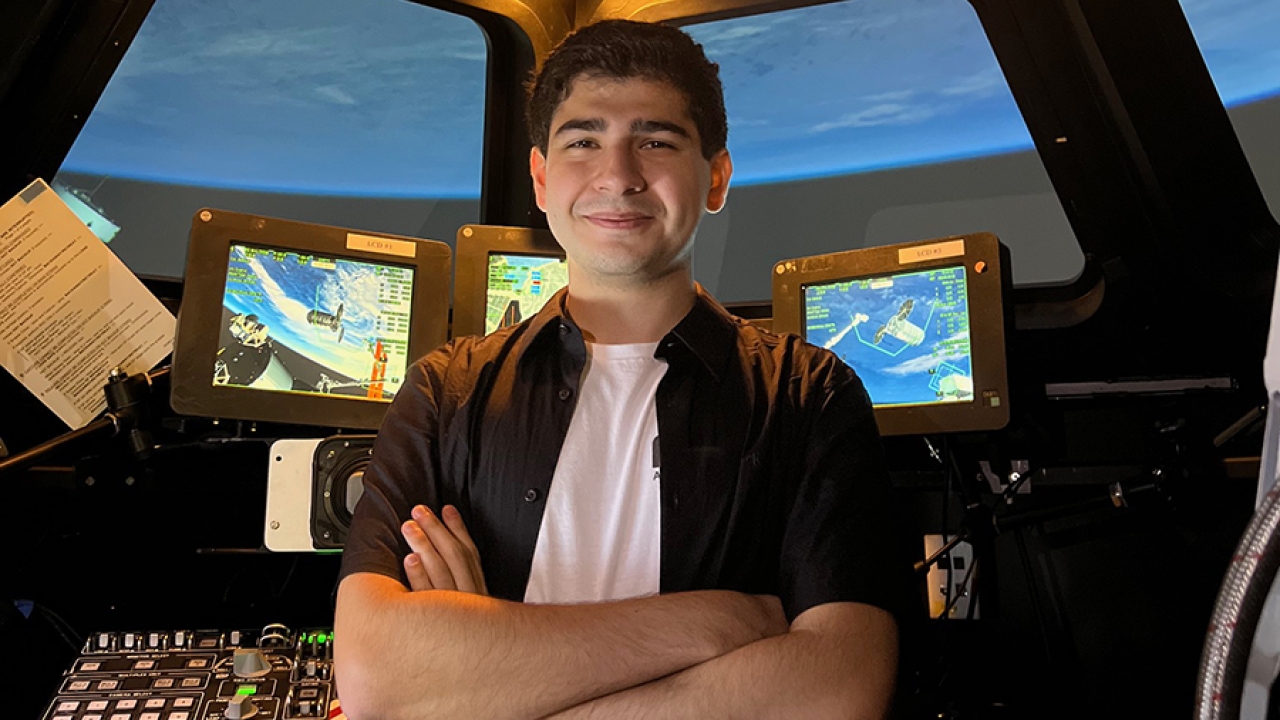
Across the Universe: Aidan Guerra's Passion for Space Spans From Stargazing to Space Missions
When people say, "shoot for the stars" they usually mean reach big for your dreams. For Aidan Guerra, it's more literal. Guerra, a third-year aerospace and mechanical engineering double major at the University of California, Davis, is not only interested in studying space but also capturing its beauty with astrophotography.

Guerra started astrophotography, which is photographing astronomical objects, celestial events, or the night sky, six years ago, but his love of space comes from long before that.
"I have loved space ever since I was young," said Guerra. "I did this moon phase project in fifth grade, and that required me to go out and draw or report the phases of the moon, the features I saw, the craters, maria [or large, dark basaltic plains] and valleys. That stood out to me compared to everything else I learned in class."
Ever since, Guerra has been all about space. Shortly after this fifth-grade lesson, he got his first telescope from Craigslist and shot all the photos on his cell phone camera through the lens of the telescope.
"I learned the fundamentals of astrophotography by taking pictures with the cell phone into the tube of the telescope and just hoping for the best," said Guerra.
Since then, he has made a few upgrades. Guerra constructed his own telescope rig that's almost fully automated with a Stellarvue refractor telescope and a ZWO dedicated astronomy camera to take photos of deep sky objects such as star clusters, like Messier 45, also known as the Seven Sisters (you've probably seen them on Subarus), which contains over a thousand stars and is an estimated 445 light-years away from Earth.
Hands-on Experience at NASA and UC Davis
Guerra's love for space has also spanned greatly into his studies and future goals. When thinking about pursuing an aerospace engineering major, he noticed the interconnected relationship between UC Davis and NASA.

"I saw that there were a lot of grants and research opportunities between NASA and Davis, so I figured there would be plenty of room for hands-on experience," said Guerra.
By the end of his first year, Guerra was taking advantage of the opportunities the space agency had to offer.
This past summer, for instance, Guerra completed an internship at NASA Ames Research Center working on computational drag analyses for aircraft and contributing to parametric vehicle models within Python. During that internship, he was mentored by UC Davis alumni who now work for NASA's Aeronautics Branch.
Currently, Guerra is now on his third internship with NASA, tracking technology transitions and infusions for the Space Technology Mission Directorate at NASA Headquarters, that have been developed either by NASA or industry and following their path to their full development in a demonstration or flight test. So far he has contributed to NASA's Technology Portfolio Management System, a comprehensive resource for locating detailed information for NASA-funded technologies, and has interviewed principal investigators to gain insights about their projects.
Guerra works this internship full-time while taking classes and in between research in the Bioastronautics and eXploration Systems Laboratory, led by Assistant Professor of Mechanical and Aerospace Engineering Rich Whittle. Guerra supports the lab's efforts in understanding the physiological effects induced by the space environment on the human body and developing tools to mitigate risk in human spaceflight.
"It's been a great experience," said Guerra, who has spent time at NASA's Johnson Space Center and will fly out NASA Headquarters in Washington, D.C. this winter. "I'm getting to explore the world, while also exploring my passion for space exploration."
Guerra hopes to encourage students from all backgrounds to unearth their own interest in the space industry through his involvement in the Aggie Space Initiative. As co-founder of the club, which is in its second year, Guerra helps foster his peers' fascination with space through proposals to NASA design challenges (the club is currently submitting proposals to NASA Micro-g NExT and NASA Human Lander Challenge).
Astronomical (Literally) Goals
After finishing his undergraduate degree, Guerra aims to complete a Ph.D. in bioastronautics, with a focus on life support systems.
Guerra also has an astrophotographical aspiration, as well: "I want to discover my own comet at some point in my life."

His favorite astrophoto he has taken was of Comet Tsuchinshan-ATLAS, one of the many comets he has photographed over the last six years. On October 13, 2024, Guerra, along with friends and family, went to check out the comet, which was one of the brightest comets the Northern Hemisphere had seen since Comet NEOWISE in July 2020 and Comet Hale Bopp in the mid '90s.
Between the awe of space and being with loved ones, Guerra was stunned by this experience. It invigorated his interest in the connection between humans and space.
"It was really beautiful to see something that wasn't there a week ago, suddenly appear in the night sky," said Guerra. "Photographing these celestial visitors reminds me of how dynamic our solar system is, and the importance of human exploration beyond our planet for the advancement of our knowledge and benefit as a species."



